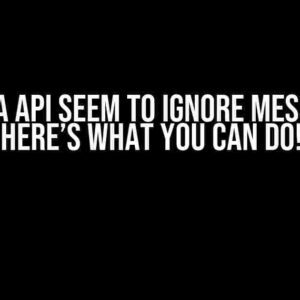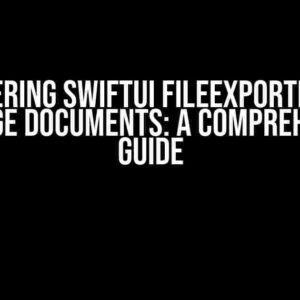Are you tired of staring at a blank screen after installing your Flutter app on an iOS device? You’re not alone! Many developers have faced this frustrating issue, and today, we’re going to dive into the reasons behind it and provide you with a step-by-step guide to troubleshoot and fix the problem.
- Understanding the Issue
- Step 1: Verify Your Xcode Project Configuration
- Step 2: Update Your Flutter Framework
- Step 3: Check for Issues with the iOS Simulator or Physical Device
- Step 4: Clean and Rebuild Your Xcode Project
- Step 5: Archive and Export Your App
- Additional Troubleshooting Steps
- Conclusion
Understanding the Issue
Before we dive into the solutions, let’s understand what might be causing the issue. There are several possible reasons why your Flutter app won’t run on an iOS device after installation:
- Configuration issues in the Xcode project
- Incorrectly configured iOS deployment target
- Issues with the Flutter framework
- Problems with the iOS simulator or physical device
Step 1: Verify Your Xcode Project Configuration
Let’s start by ensuring that your Xcode project is correctly configured. Follow these steps:
- Open your Flutter project in Xcode by navigating to the
ios/Runner.xcworkspacefile. - In the Xcode project navigator, select the
Runnertarget. - Go to the
Generaltab and ensure that theTeamandBundle Identifierare correctly set. - Make sure the
iOS Deployment Targetis set to the desired iOS version.
Checking the iOS Deployment Target
The iOS deployment target specifies the minimum iOS version that your app supports. If you’re using an older version of Flutter, you might need to update the deployment target to match the minimum iOS version supported by the framework. You can do this by:
flutter run --deployment-target=12.0Replace 12.0 with the desired iOS version.
Step 2: Update Your Flutter Framework
Sometimes, issues can arise due to outdated Flutter framework versions. Let’s update Flutter to the latest version:
flutter upgradeThis will update your Flutter framework to the latest version.
Step 3: Check for Issues with the iOS Simulator or Physical Device
Now, let’s focus on the iOS simulator or physical device. Follow these steps:
- Restart your iOS simulator or physical device.
- If you’re using a physical device, make sure it’s properly connected to your Mac.
- Try running the app on a different iOS simulator or physical device to isolate the issue.
- If you’re using a physical device, try resetting the device’s settings:
Settings > General > Reset > Reset All SettingsStep 4: Clean and Rebuild Your Xcode Project
Sometimes, a simple clean and rebuild can resolve the issue. Follow these steps:
- In Xcode, go to
Product > Clean. - In the terminal, navigate to the
iosdirectory and run:
flutter cleanflutter pub getStep 5: Archive and Export Your App
If the issue persists, let’s try archiving and exporting your app:
- In Xcode, go to
Product > Archive. - Once the archiving process is complete, click on
Export.... - Select
Export as > App Store Connect. - Follow the prompts to export the app.
- Try installing and running the app on your iOS device.
Additional Troubleshooting Steps
If the above steps don’t resolve the issue, here are some additional troubleshooting steps:
- Check the Xcode console for any error messages.
- Verify that your app’s
Info.plistfile is correctly configured. - Try running the app on a different Mac or in a different environment.
- Check for any conflicts with other apps or services running on your iOS device.
Conclusion
By following these steps, you should be able to resolve the issue of your Flutter app not running on an iOS device after installation. Remember to stay calm, patient, and methodical in your troubleshooting approach. If you’re still facing issues, don’t hesitate to seek help from the Flutter community or online forums.
| Troubleshooting Step | Description |
|---|---|
| Verify Xcode Project Configuration | Check that the Xcode project is correctly configured, including the team, bundle identifier, and iOS deployment target. |
| Update Flutter Framework | Update the Flutter framework to the latest version using flutter upgrade. |
| Check iOS Simulator or Physical Device | Restart the iOS simulator or physical device, and try running the app on a different device or simulator. |
| Clean and Rebuild Xcode Project | Clean and rebuild the Xcode project using flutter clean and flutter pub get. |
| Archive and Export App | Archive and export the app using Xcode, and try installing and running the app on the iOS device. |
We hope this comprehensive guide has helped you resolve the issue and get your Flutter app up and running on your iOS device. Happy coding!
Here is the HTML code with 5 questions and answers about “flutter App (ios) doesn’t run after installation”:
Frequently Asked Questions
Stuck with your Flutter app that refuses to run on iOS after installation? Fear not, dear developer! We’ve got you covered.
Why does my Flutter app not run on iOS after installation?
This issue might be due to a variety of reasons such as incorrect configuration, missing permissions, or even a simple typo in your code. But don’t worry, we’ll help you troubleshoot and identify the root cause!
Have I missed any essential permissions or settings in my Flutter app?
Double-check that you’ve added the necessary permissions in your Info.plist file, such as the camera or location permissions, depending on your app’s requirements. Also, ensure that your app’s Bundle Identifier and Version number are correct.
Could it be related to my entitlements, certificates, or provision profiles?
Yes, that’s a good point! Make sure your entitlements, certificates, and provision profiles are correctly set up and configured. You can check the Apple Developer portal or Xcode to ensure everything is in order.
Is there a chance that my Flutter app is not compiled correctly?
It’s possible! Try running `flutter clean` and then `flutter run` to rebuild and re-run your app. If the issue persists, you can try deleting the Derived Data folder in Xcode or resetting the Simulator.
What if I’ve tried everything and my Flutter app still won’t run on iOS?
Don’t worry, we’re not giving up on you! If you’ve tried all the above steps and your app still won’t run, you can try seeking help from the Flutter community, checking the Flutter documentation, or even reaching out to Apple support for further assistance.
Feel free to modify the questions and answers to fit your specific use case!



